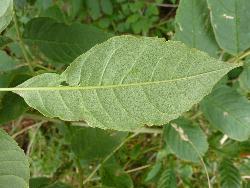- Taxon
- Weed
- Gallery
Widespreading tree to c. 15 m high. Shoots with glandular hairs; lf scars not prominent. Buds brown-tomentulose. Lvs to c. 60 cm long; petiole and rachis to c. 40 cm long, densely clothed in glandular hairs. Leaflets 9–17, sessile or nearly so, becoming glabrous or nearly so above, densely hairy with simple and stellate hairs on the veins beneath and midrib glandular, serrulate with teeth often sparse; base obliquely truncate or subcordate; apex acute to acuminate; lowest pair of leaflets often smaller; terminal leaflet mostly of similar size to lateral leaflets. Lamina of terminal leaflet 6–18 × 3–8 cm, oblong or oblong-ovate. ♂ catkins to c. 15 cm long, with glandular hairs. ♀ catkins 9–22-flowered, ± tomentose with purplish glandular hairs; stigmas 6–7 mm long, prominent, pink. Fr. 2.5–4 cm long, broad-ovoid, beaked, viscid, tomentose, ferrugineus. Shell rugose, thick, ± subcordate at base; sutures thick and raised, dividing with difficulty; beak often sharply acute. Seed convoluted.
[From: Webb et al. (1988) Flora of New Zealand. Volume 4.]
| Category | Number |
|---|---|
| Exotic: Fully Naturalised | 1 |
| Total | 1 |
Flowering: Oct.–Nov.




